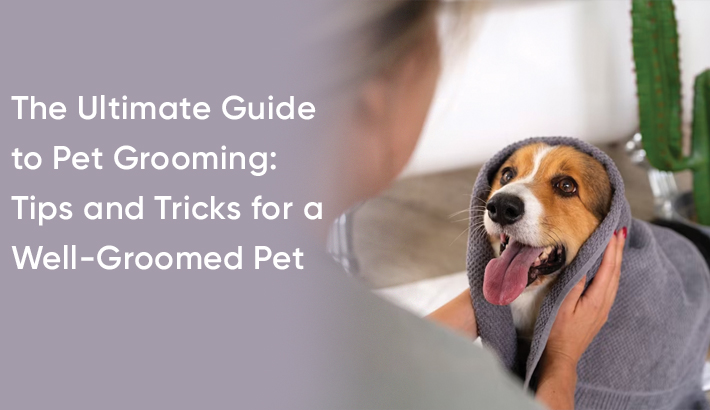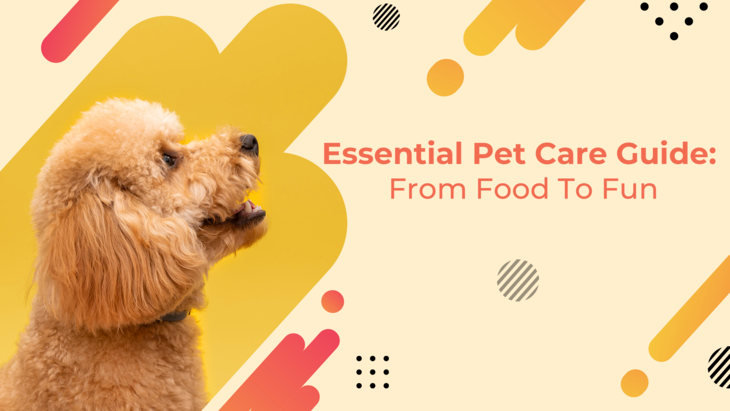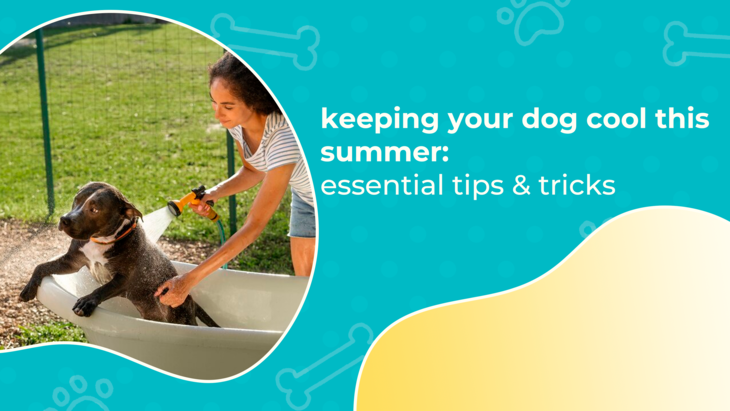Importance of Pet Grooming
Pet grooming is not just about keeping your pet looking good; it is also an essential part of their overall health and well-being. Regular grooming helps prevent various issues such as matting, skin irritations, and infections. It also allows you to keep an eye out for any abnormalities or changes in your pet's body, such as lumps or skin problems. Grooming also helps maintain the cleanliness of your home by reducing shedding and controlling odors. Additionally, grooming provides an opportunity for bonding with your pet and can help them feel more comfortable and relaxed.
Proper grooming is especially crucial for long-haired breeds, as their fur tends to mat easily and can lead to discomfort and health problems if not properly cared for. However, even short-haired pets benefit from regular grooming to keep their coat shiny, healthy, and free from debris.
To ensure your pet's grooming needs are met, it is important to establish a grooming routine from an early age. This will help your pet get accustomed to the process and make grooming a stress-free experience for both of you.
Benefits of Regular Pet Grooming
Regular grooming offers numerous benefits for your pet's health and appearance. Here are some key advantages:
1. Healthier Skin and Coat: Regular brushing stimulates the production of natural oils in your pet's skin, resulting in a healthier and shinier coat. It also helps remove dead hair and dandruff, preventing matting and reducing the risk of skin infections.
2. Improved Circulation: Brushing your pet's fur helps stimulate blood flow to the skin, promoting better circulation and healthier skin overall.
3. Early Detection of Health Issues: During grooming sessions, you have the opportunity to check for any abnormalities or changes in your pet's body, such as lumps, bumps, or skin irritations. Early detection of these issues can lead to timely veterinary intervention and better treatment outcomes.
4. Reduced Shedding: Regular brushing removes loose hair and reduces shedding, which means less hair on your furniture and clothes. It also helps prevent hairballs in cats, which can be a common issue for grooming.
5. Improved Hygiene: Regular grooming includes nail trimming, ear cleaning, and teeth brushing, which all contribute to better overall hygiene for your pet. Clean ears, trimmed nails, and healthy teeth can help prevent infections and other oral or ear-related problems.
Remember, grooming is not just about appearances; it is an essential part of your pet's overall health and well-being. By incorporating regular grooming into your pet's routine, you can ensure they look and feel their best.
Basic Pet Grooming Supplies
Before you start grooming your pet, it is important to have the right tools and supplies on hand. Here are some basic grooming supplies that every pet owner should have:
1. Brushes and Combs: Choose brushes and combs that are suitable for your pet's coat type. For long-haired pets, a slicker brush or a pin brush can help remove tangles and mats. For short-haired pets, a rubber brush or a grooming glove is ideal for removing loose hair.
2. Nail Clippers: Invest in a good quality pair of nail clippers that are specifically designed for pets. Regular nail trimming is important to prevent overgrowth, which can lead to discomfort and difficulty walking.
3. Ear Cleanser: Use a veterinarian-recommended ear cleanser to gently clean your pet's ears. This helps prevent ear infections and removes any dirt or debris.
4. Toothbrush and Toothpaste: Regular brushing is essential for maintaining your pet's dental health. Use a toothbrush and toothpaste designed specifically for pets, as human toothpaste can be harmful to them.
5. Shampoo and Conditioner: Choose a pet-friendly shampoo and conditioner that is suitable for your pet's coat type. Avoid using human products, as they can be too harsh for your pet's sensitive skin.
6. Towels and Drying Tools: Have plenty of towels on hand to dry your pet after bathing. You may also want to invest in a pet-specific hairdryer or use a low-heat setting on your own hairdryer to speed up the drying process.
Having these basic grooming supplies readily available will make your grooming sessions more efficient and enjoyable for both you and your pet.
Step-by-Step Guide to Pet Grooming
Now that you have the necessary supplies, it's time to dive into the step-by-step process of pet grooming. Follow this guide to ensure a successful grooming session:
1. Preparation: Choose a quiet and comfortable space for grooming. Gather all the necessary supplies and keep them within reach. Ensure that your pet is calm and relaxed before you begin.
2. Brushing: Start by brushing your pet's fur to remove any tangles or mats. Use gentle, slow strokes, and be extra careful around sensitive areas such as the face, ears, and tail. This step helps remove loose hair, stimulates the skin, and prepares your pet for a bath if needed.
3. Bathing: If your pet needs a bath, use lukewarm water and a pet-friendly shampoo. Wet your pet's coat thoroughly and apply the shampoo, massaging it gently into the fur. Rinse thoroughly to remove all the shampoo, ensuring no residue is left behind. Take care to avoid getting water or soap in your pet's eyes, ears, or nose.
4. Drying: After bathing, use a towel to gently pat your pet dry. If your pet is comfortable with it, you can also use a hairdryer on a low-heat setting. Ensure that the dryer is kept at a safe distance from your pet's skin to prevent burns.
5. Nail Trimming: Trim your pet's nails using the appropriate nail clippers. Take care not to cut into the quick, which is the sensitive part of the nail. If you are unsure about this process, consult a professional groomer or your veterinarian for guidance.
6. Ear Cleaning: Use a veterinarian-recommended ear cleanser and a cotton ball to gently clean your pet's ears. Avoid inserting anything into the ear canal, as this can cause injury. If you notice any redness, swelling, or discharge, consult your veterinarian.
7. Teeth Brushing: Use a toothbrush and toothpaste designed for pets to brush your pet's teeth. Start by getting your pet accustomed to the taste of the toothpaste, then gradually introduce the toothbrush. Brush in gentle circular motions, focusing on the outer surfaces of the teeth.
8. Finishing Touches: After grooming, give your pet a final brush to remove any loose hair and ensure their coat looks smooth and shiny. Reward your pet with treats and praise for their good behavior during the grooming session.
By following these step-by-step instructions, you can ensure a successful grooming session for your pet. Remember to be patient and take breaks if needed, especially if your pet becomes anxious or uncomfortable.
Tips for Grooming Different Types of Pets - Dogs, Cats, and Small Animals
Each pet has unique grooming needs, and it is important to tailor your grooming routine accordingly. Here are some tips for grooming different types of pets:
Dogs:
1. Breed-Specific Grooming: Different dog breeds have specific grooming requirements. Research your dog's breed and consult breed-specific grooming guides to ensure you are meeting their unique needs.
2. Coat Maintenance: Regular brushing is essential for most dogs to prevent matting and keep their coat healthy. Long-haired breeds may require more frequent brushing to prevent tangles.
3. Bathing Frequency: How often you bathe your dog depends on their breed, coat type, and activity level. Over-bathing can strip the natural oils from their skin, leading to dryness and irritation.
4. Nail Trimming: Dogs' nails should be trimmed regularly to prevent overgrowth and discomfort. If you are unsure about nail trimming, consult a professional groomer or your veterinarian.
5. Ear Care: Check your dog's ears regularly for any signs of infection or irritation. Clean them as needed using a veterinarian-recommended ear cleanser.
6. Teeth Cleaning: Regular dental care is important for dogs to prevent dental disease. Brush their teeth regularly using a toothbrush and toothpaste designed for dogs.
Cats:
1. Brushing: Regular brushing helps prevent matting and hairballs in cats. Use a brush or grooming glove that is suitable for your cat's coat type.
2. Nail Trimming: Cats' nails should be trimmed regularly to prevent overgrowth and scratching. If your cat is resistant to nail trimming, consult a professional groomer or your veterinarian.
3. Bathing: Most cats are self-groomers and do not require frequent baths. However, if your cat becomes dirty or has a skin condition, consult your veterinarian for guidance on bathing.
4. Ear Care: Check your cat's ears regularly for any signs of infection or irritation. Clean them as needed using a veterinarian-recommended ear cleanser.
5. Teeth Cleaning: Dental care is important for cats to prevent dental disease. Introduce toothbrushing slowly and gradually to get your cat accustomed to the process.
Small Animals:
1. Brushing: Some small animals, such as rabbits and guinea pigs, may require regular brushing to prevent matting and to remove loose hair.
2. Bathing: Most small animals do not require regular baths. However, if your pet becomes dirty, consult your veterinarian for guidance on bathing techniques and products.
3. Nail Trimming: Small animals' nails should be trimmed regularly to prevent overgrowth. Consult a professional groomer or your veterinarian for guidance on nail trimming.
4. Ear Care: Check your small animal's ears regularly for any signs of infection or irritation. Clean them as needed using a veterinarian-recommended ear cleanser.
5. Teeth Care: Dental care is crucial for small animals to prevent dental disease. Provide appropriate chew toys and consult your veterinarian for guidance on dental care.
By understanding the specific grooming needs of different pets, you can ensure that your furry friends receive the care they require.
Common Pet Grooming Mistakes to Avoid
While grooming your pet, it's important to be aware of common mistakes that pet owners often make. Avoiding these mistakes will help ensure a safe and successful grooming experience for both you and your pet. Here are some common pet grooming mistakes to avoid:
1. Using the Wrong Tools: Using the wrong grooming tools can cause discomfort or injury to your pet. Make sure to choose tools that are appropriate for your pet's size, coat type, and grooming needs.
2. Skipping Brushing Before Bathing: Brushing before bathing helps remove loose hair and prevents matting. Skipping this step can make the bathing process more difficult and may lead to tangles and discomfort for your pet.
3. Not Using Pet-Friendly Products:** Using human grooming products, such as shampoos or toothpaste, can be harmful to your pet's skin and health. Always choose products that are specifically formulated for pets.
4. Neglecting Nail Trimming: Neglecting nail trimming can lead to overgrowth, which can cause discomfort and difficulty walking for your pet. Regularly trim your pet's nails or seek professional help if you are unsure.
5. Rough Handling: Handling your pet roughly during grooming can cause fear or anxiety, making future grooming sessions more challenging. Always handle your pet gently and ensure they feel safe and secure.
6. Skipping Regular Grooming: Regular grooming is essential for your pet's overall health and well-being. Skipping grooming sessions can lead to matting, skin irritations, and other health issues. Establish a grooming routine and stick to it.
By avoiding these common grooming mistakes, you can provide a safe and positive grooming experience for your pet.
Dealing with Pet Grooming Challenges - Handling Anxious Pets, Matted Fur, etc.
Grooming can sometimes pose challenges, especially when dealing with anxious pets or matted fur. Here are some tips for handling common grooming challenges:
1. Anxious Pets: If your pet becomes anxious during grooming, try to create a calm and relaxed environment. Use positive reinforcement, treats, and praise to reward your pet for good behavior. Gradually introduce grooming activities and take breaks if needed.
2. Matted Fur: Matted fur can be painful and uncomfortable for your pet. To prevent matting, brush your pet regularly, especially if they have long hair. If you encounter mats, use a mat splitter or seek professional help to remove them without causing harm to your pet.
3. Sensitive Areas: Take extra care when grooming sensitive areas such as the face, ears, and tail. Use gentle strokes and ensure your pet feels comfortable and secure throughout the process.
4. Resistant Pets: Some pets may be resistant to grooming, making the process challenging. Gradual desensitization and positive reinforcement can help overcome resistance. Seek professional help if needed.
5. Handling Difficult Nails: If your pet's nails are difficult to trim, consult a professional groomer or your veterinarian for assistance. They can provide guidance and ensure the process is done safely.
Remember, patience and understanding are key when dealing with grooming challenges. Take your time, be gentle with your pet, and seek professional help when necessary.
Conclusion
In conclusion, pet grooming is not only about keeping your pet looking good, but it is also crucial for their overall health and well-being. By incorporating regular grooming into your pet's routine and following the tips and tricks outlined in this guide, you can ensure that your furry friend is always well-groomed and happy. Remember to have the necessary grooming supplies, establish a grooming routine, and tailor your grooming techniques to your specific pet's needs. Avoid common grooming mistakes and be prepared to handle any grooming challenges that may arise. With the knowledge and confidence gained from this ultimate guide, you'll become a pro at pet grooming and your furry companion will be the envy of all the neighbors. Happy grooming!







Post Comments